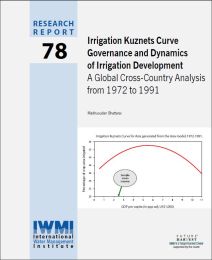Irrigation Kuznets Curve, Governance and Dynamics of Irrigation Development: A Global Cross-Country Panel Analysis from 1972 to 1991.
Citation:
Bhattarai, Madhusudan. 2004. Irrigation Kuznets Curve, governance and dynamics of irrigation development: a global cross-country analysis from 1972 to 1991. Colombo, Sri Lanka: International Water Management Institute (IWMI) vi, 47p. (IWMI Research Report 78) [doi: 10.3910/2009.020]
Abstract
This report verifies the Environmental Kuznets Curve (EKC) hypothesis for irrigation. The EKC hypothesis suggests for an inverse U-shaped (or concave) relationship between the level of environmental degradation and income in a given society. The EKC hypothesis also implies that some form of environmental deterioration appears inevitable during the initial stage of development, but subsequent increases in the societal income would generate enough incentives to improve the environmental quality. In line with this reasoning, the EKC relationship for irrigation (referred to here as Irrigation Kuznets Curve, or IKC) hypothesizes that the demand for irrigation is greater at the initial stage of development and that irrigation demand declines as societal income increases. This process subsequently gives rise to an inverted U-shaped relationship between the level of irrigation and the level of income. This information on EKC for irrigation has large implications for planning of irrigation and for analyzing demand for irrigation, and water uses and water reallocations across sectors. To test the EKC hypothesis for irrigation, a statistical analysis was performed using spatial (cross-country) and temporal (over time) data from 66 tropical countries in Asia, Africa and Latin America over the period 1972 to 1991. The EKC analysis for irrigation was first carried out for 66 tropical countries as a whole (called the tropicalglobal model), and then separately for 13 countries from Asia (called the Asia model) where more than two-thirds of global irrigated land is located. Two measures of irrigation are used: “percentage of crop area irrigated†and “relative change in net irrigated area.†In addition, the impacts of underlying institutions and structural factors on the spatial and temporal variation of irrigation development in the tropical countries were evaluated.The empirical results suggest a confirmation of the EKC relationship for irrigation—that is, there is statistically verified evidence of the inverted U-shaped relationship between irrigation and income level cross tropical countries. This is established for the two measures of irrigation noted above, and for both the tropical-global and the Asia models. The results imply that the demand for irrigation development in a country (region) is higher at the initial stage of development and will gradually decrease as the income increases, and subsequently gives rise to an EKC for irrigation (or inverted U-shaped) relationship in the economy. This means also that the income effect is one of the critical components in the irrigation development process across the countries. In addition to income growth, we also found that other factors (other than income) also significantly affect the level of irrigation development at any point of time. They are institutions and public policy related factors such as macro economic policy, agricultural productivity, types of structural change in the economy, electricity use, and underlying public institutions and governance structures (quality of the governing institutions). An important policy implication of the EKC for irrigation is that the irreversible damage to the water-sector environment, while allowing for a normal path of the irrigation development, can be potentially avoided by selecting appropriate policy and institutional tools. This allows for adjusting irrigation expansion below the ecological threshold limit of the region, and such policy-induced changes in irrigation will provide a win-win situation that is also consistent with the basic concept of sustainable development. The information on the inverted U-shaped relationship between irrigation and income vi established from the EKC analysis has also large implications in analyzing demand for irrigation in an economy. Past studies on irrigation demand have mostly assumed a fixed per capita requirement-based criteria and zero-income elasticity of irrigation, ignoring the income effects and the underlying societal trade-offs and substitution behavior. As opposed to that, the information on inverted U-shaped income elasticity of irrigation derived from the EKC analysis, if incorporated in irrigation forecasting models (or hydrological models), could greatly improve the accuracy and efficiency of irrigation demand estimation models. This information also has implications for public policy debates on water uses for food production versus environmental protection; and how irrigation and water (re)allocation decisions at any point of time are affected by income, policies, and underlying institutional factors.
ISBN 92-9090-523-9
ISSN1026-0862


